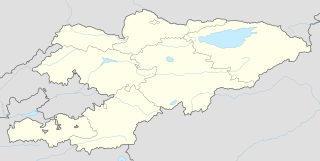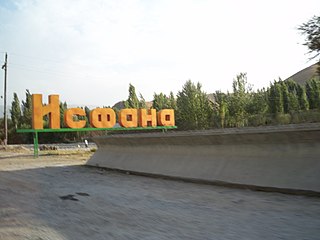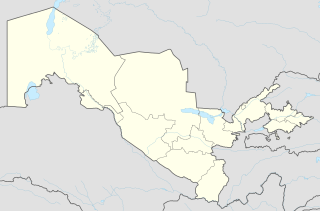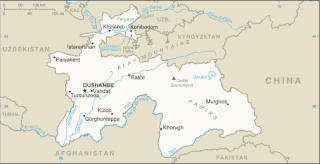
Kyrgyzstan is a landlocked nation in Central Asia, west of the People's Republic of China. Less than a seventh the size of Mongolia, at 199,951 square kilometers, Kyrgyzstan is one of the smaller Central Asian states. The national territory extends about 900 km (560 mi) from east to west and 410 km (250 mi) from north to south.

Kyrgyzstan, officially the Kyrgyz Republic, also known as Kirghizia, is a landlocked country in Central Asia. It is bordered by Kazakhstan, Uzbekistan, Tajikistan and China. Its capital and largest city is Bishkek.

The Fergana Valley is a valley in Central Asia spread across eastern Uzbekistan, southern Kyrgyzstan and northern Tajikistan.

Osh is the second largest city in Kyrgyzstan, located in the Fergana Valley in the south of the country and often referred to as the "capital of the south". It is the oldest city in the country, and has served as the administrative center of Osh Region since 1939. The city has an ethnically mixed population of about 281,900 in 2017, comprising Uzbeks, Kyrgyz, Russians, Tajiks, and other smaller ethnic groups. It is about 5 km from the Uzbekistan border.

Batken is a small town in southwestern Kyrgyzstan, on the southern fringe of the Fergana Valley. It is the capital of Batken Region. Its area is 205 square kilometres (79 sq mi), and its resident population was 19,718 in 2009. The population of the town proper was 13,435.

Batken Region is a region (oblast) of Kyrgyzstan. Its capital is Batken. It is bounded on the east by Osh Region, on the south, west and north by Tajikistan, and on the northeast by Uzbekistan. The northern part of the region is part of the flat, agricultural Ferghana Valley. The land rises southward to the mountains on the southern border: the Alay Mountains in the east, and the Turkestan Range in the west.

Osh Region is a region (oblast) of Kyrgyzstan. Its capital is Osh. It is bounded by (clockwise) Jalal-Abad Region, Naryn Region, Xinjiang, China, Tajikistan, Batken Region, and Uzbekistan.

Isfana is a small town in the extreme western end of Batken Region in southern Kyrgyzstan. Isfana is on the southern fringe of the Fergana Valley in a region surrounded on three sides by Tajikistan.

Sughd Province is one of the four administrative divisions and one of the three provinces that make up Tajikistan. Centered in the historical Sogdiana, it is located in the northwest of the country, with an area of some 25,400 square kilometers and a population of 2,707,300, up from 2,233,550 according to the 2010 census and 1,871,979 in 2000. The capital is Khujand. It was founded in 1924 as part of Uzbek SSR and transferred to Tajik SSR by Soviet Communists in 1929. Today, the province is still home to many ethnic Uzbeks. The Province's ethnic composition in 2010 was 84% Tajik, 14.8% Uzbek, 0.6% Kyrgyz, 0.4% Russian and 0.1% Tatar.
Terrorism in Tajikistan stems largely from the forces of political opposition who opposed the comprehensive peace agreement that ended the civil war in 1997. President Emomali Rahmonov and UTO leader Said Abdullah Nuri signed the agreement on 27 June, believing it would bring an end to hostilities. However, dissident Islamist militants led by Tohir Yo‘ldosh and Juma Namangani formed the Islamic Movement of Uzbekistan in 1998, allying with Al-Qaeda and vowing to unite Central Asia as an Islamic state. The latest terror attacks took place in the Qabodiyon District on November 6, 2019 when a policeman and a border guard were killed by several Islamic State militants. 15 terroristi were also killed.

The Uzbekistan–Kyrgyzstan barrier is a border barrier built by Uzbekistan along its border with Kyrgyzstan to prevent terrorist infiltration. Construction began in 1999 after bomb attacks in the Uzbek capital of Tashkent were blamed on Islamic terrorists originating from Kyrgyzstan. The fence, unilaterally erected in disputed territory has caused economic hardships in the poor agricultural areas of the Ferghana Valley and has separated many families in this traditionally integrated border region.

Shohimardon is a small town in Fergana District of Fergana Region in eastern Uzbekistan. It is an exclave of Uzbekistan, surrounded by Kyrgyzstan, in a valley in the Pamiro-Alai mountains.

As of 1996, China–Kyrgyzstan relations were an area of substantial uncertainty for the government in Bishkek. The free-trade zone in Naryn attracted large numbers of Chinese businesspeople, who came to dominate most of the republic's import and export of small goods. Most of this trade is in barter conducted by ethnic Kyrgyz or Kazakhs who are Chinese citizens. The Kyrgyzstani government had expressed alarm over the numbers of Chinese who were moving into Naryn and other parts of Kyrgyzstan, but no preventive measures had been taken as of 1996.
The Osh riots were an ethnic conflict between Kirghiz (Kyrgyz) and Uzbeks that took place in June 1990 in the cities of Osh and Uzgen, part of the Kirghiz SSR. The immediate cause of the riots was a dispute between an Uzbek nationalist group Adolat and a Kyrgyz nationalist group Osh Aymaghi over the land of a former collective farm. While official estimates of the death toll range from over 300 to more than 600, unofficial figures range up to more than 1,000. The riots have been seen as a forerunner to the 2010 ethnic clashes in the same region.

Barak is a Kyrgyz village that is surrounded by the territory of Uzbekistan. Its de facto status as one of the world's 91 current international enclaves began in 1999. Administratively it is part of Kara-Suu District in Kyrgyzstan's Osh Region and is encircled by the Andijan Region of Uzbekistan. Its population was 627 in 2009.

Soʻx District is a tuman (district) of the Fergana Region. It is an exclave of Uzbekistan, surrounded by Kyrgyzstan. Its capital is Ravon. Another village in the district is Limbur. It is noted that despite being a part of Uzbekistani territory and being surrounded by Kyrgyzstan, its population is mostly Tajik.

Cholpon Orozobekova is a prominent Kyrgyz journalist, mediapreneur, human rights activist and an analyst on Central Asian issues currently based in Geneva.

The Batken Conflict was a period of armed clashes between militants of the Islamic Movement of Uzbekistan (IMU) and the Armed Forces of Kyrgyzstan, with support to the latter being provided by the Uzbek Ground Forces. It was caused by incursions of IMU militants into Uzbek and Kyrgyz territory from Tajikistan and was in part, centered on the unilateral demarcation of the Kyrgyzstan–Uzbekistan border by Uzbekistan.

The Kyrgyzstan–Tajikistan border is 984 km (611m) and runs from the tripoint with Uzbekistan to the tripoint with China.














